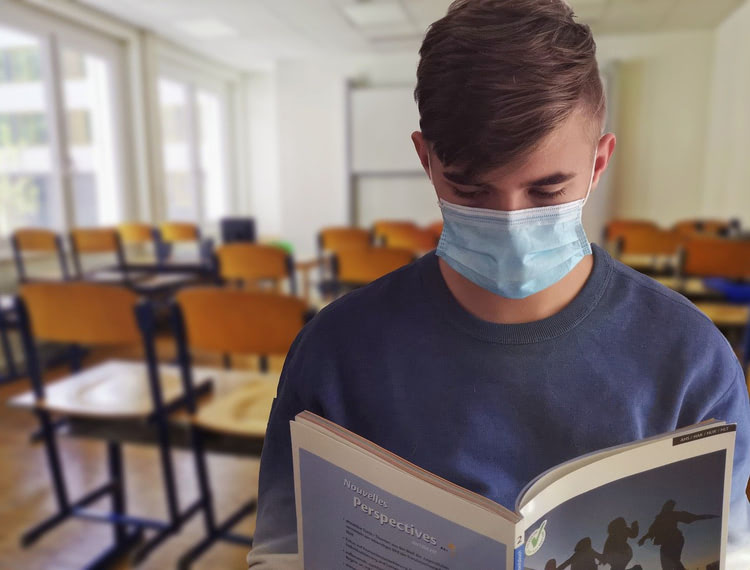New guidance for education settings during national restrictions

On Saturday the Prime Minister @BorisJohnson announced that, from today (5 Nov), the country will enter a new period of national restrictions until at least 2 December. Unlike the last national lockdown in the spring, this time schools, nurseries and other education settings will remain open to all pupils, not just vulnerable pupils and children of key workers. University Students should only return home at the end of term for Christmas.
The Prime Minister said:
“My priority, our priority, remains keeping people in education – so childcare, early years settings, schools, colleges and universities will all remain open. Our senior clinicians still advise that school is the best place for children to be.
“We cannot let this virus damage our children’s futures even more than it has already. I urge parents to continue taking their children to school, and I am extremely grateful to teachers across the country for their dedication in enabling schools to remain open.”
From today, national restrictions are in force in England.
Click below for all you need to know.
https://t.co/shgzOurdZCpic.twitter.com/teu59b57Vd— UK Prime Minister (@10DowningStreet) November 5, 2020
Schools and colleges
- Schools remain open for all children and young people as they have since the start of the autumn term
- On 2 July we published guidance to support schools to welcome back all children from the start of the autumn term. Schools should continue to refer to this guidance. The measures set out in the guidance provide a framework for school leaders to put in place proportionate protective measures for pupils and staff. If schools follow the guidance and maximise control measures, they can be confident they are managing risk effectively
- Face coverings should be worn by students and staff in secondary schools and further education colleges in communal spaces, outside of classrooms, where social distancing cannot be maintained
- The guidance is clear that primary school children do not need to wear face coverings, and older children and young people with special educational needs or disabilities may be exempt from wearing them, depending on their need
- No one should be excluded from education for not having a face covering.
- Primary schools continue to have discretion to recommend staff and visitors wear face coverings in communal spaces where social distancing cannot be maintained, but this is not a requirement and it is for individual schools to make these decisions locally.
- Face coverings should also be worn by pupils in year 7 and above when travelling on dedicated school transport to secondary school or college
- Further Education settings will remain open. Face coverings should now be used outside of classrooms where social distancing is not possible
Face coverings should now be worn in communal areas outside of classrooms in all secondary schools and further education settings. For detailed information on the updated guidance, visit: https://t.co/FprLvAQHotpic.twitter.com/3xhartEzdu
— Department for Education (@educationgovuk) November 5, 2020
Nurseries, other early years settings and childcare
- Nurseries, childminders and other forms of Ofsted registered early years provision are encouraged to stay open
- In early years settings, adults should now wear face coverings in communal areas where social distancing with other adults cannot be maintained. This does not apply to classrooms or areas where staff routinely interact with children
- Families are also able to form a childcare bubble with another household for the purposes of informal childcare, where the child is 13 or under, as part of a consistent childcare arrangement
Higher education
- Universities and adult learning settings should consider moving appropriate provision online. Like everyone, students should remain in their current accommodation
- Students should only return home at the end of term for Christmas
From 5th November until 2 December, new national restrictions apply in England. For information on how this affects universities and students, visit: https://t.co/E2LQEoZ1UDpic.twitter.com/zu3fUSvrhe
— Department for Education (@educationgovuk) November 3, 2020
Face coverings recommended for staff and students in year 7 and above in communal areas outside of classrooms – guidance to be implemented as soon as possible, with leeway until Monday 9 November if needed
The government yesterday published guidance for education settings ahead of national restrictions coming into force from Thursday 5 November, building on the guidance first published in July.
During the national restrictions, face coverings should be worn by students and staff in secondary schools and further education colleges in communal spaces, outside of classrooms, where social distancing cannot be maintained.
The guidance is clear that primary school children do not need to wear face coverings, and older children and young people with special educational needs or disabilities may be exempt from wearing them, depending on their need. No one should be excluded from education for not having a face covering.
Primary schools continue to have discretion to recommend staff and visitors wear face coverings in communal spaces where social distancing cannot be maintained, but this is not a requirement and it is for individual schools to make these decisions locally.
The requirements in relation to face coverings were already in place for schools in Local Alert Level High and Very High areas.
Schools should work to implement the guidance as soon as possible, but have until Monday 09 November if they require additional time.
 Education Secretary Gavin Williamson said:
Education Secretary Gavin Williamson said:
“We must put the interests of our children and young people first, especially when the benefits of being in the classroom are clear.
“Children are settled back into their routines and schools have protective measures in place keep their staff and pupils as safe as possible.
“Education is a national priority and we cannot allow it to be disrupted again.”
 Kevin Courtney, Joint General Secretary of the National Education Union, said:
Kevin Courtney, Joint General Secretary of the National Education Union, said:
“With grating familiarity, the Government has once again delivered new guidance to schools at the eleventh hour.
“The growth of virus cases in secondary schools is shocking, with cases 50 times higher on October 23 than at the start of September. Cases were also nine times higher in primary schools. The virus levels are leading to many children being sent home as bubbles close.
“Clearly the Government needs to find ways to break transmission networks in schools and colleges. It must prioritise schools for access to rapid turnaround tests like those being trialled in Liverpool, and should be making plans for secondary schools and sixth form colleges to move to a rota operation where children are taught every lesson but are at home some of the time.
“It is absolutely right for the government to say that clinically extremely vulnerable staff and students should be working at home.
“Requiring face coverings when moving around secondary schools is welcome, but their use more widely must be considered and other measures must be taken on social distancing. Much more needs to be done to make schools and colleges safe.
“We cannot afford this Government’s constant slow responses. The opportunity for a circuit-break at half term was squandered. Now we have this second lockdown, which will not work if schools and colleges stay open without the safety measures needed to prevent the steady rise in cases which ultimately spreads to the wider community. We need more extensive solutions and in particular a plan for rota operations after we emerge from this late lockdown.”
The guidance published today continues the government’s approach to prioritising pupils’ full time education in school. There are currently no plans for school closures or to implement rota systems. Any changes to attendance would be implemented as a last resort.
Our existing guidance published in July sets out a range of measures to reduce the risk of transmission, including physical distancing between staff and pupils and increased ventilation in classrooms where possible.
Evidence has highlighted the risks of not being in education on young people’s development and mental health. As the UK’s Chief Medical Officers have made clear: the wider risks to children being out of school is far greater than the risk of catching coronavirus at school.
Following a Cabinet chaired by the Prime Minister on Saturday (31 Oct), Boris Johnson announced tougher national restrictions in England.
From Thursday, everyone must stay at home, with a limited set of exemptions.
With the NHS weeks from being overwhelmed, and a higher death toll than the first wave predicted without new restrictions, the Prime Minister, Chief Medical Officer, Chief Scientific Advisor, and Cabinet agreed there was no alternative to tougher national measures.
The Prime Minister updated Parliament on Monday (2 Nov), and MPs are set to vote on the measures today (4 Dec).
He said that no one wants to impose these kinds of measures, but no responsible Prime Minister could ignore the evidence presented. He also said that, whilst Christmas will inevitably be different this year, tough action now could mean families may be able to be together.
Three-tier lockdown system – Schools and University Campuses will remain open
On 12 Oct, the Prime Minister confirmed that Schools and Univerisity campuses would remain open as he set out a three-tier system for England, with Liverpool region under strictest tier, in a statement to the House of Commons.
The University and College Union (UCU) have said the Prime Minister was wrong to declare that universities will stay open under new local restrictions. The union said institutions across the UK need to move to online learning as the default position to prevent more regions entering into new restrictions as Covid infection rates at universities in England and Wales are up to seven times higher than those in the local population, posing a significant public health risk.
 UCU general secretary Jo Grady said:
UCU general secretary Jo Grady said:
‘Some local areas are now being forced into harsh lockdowns, which will have severe financial consequences. We have been warning the government for months that a mass return to campus would likely lead to big Covid outbreaks, but the Prime Minister is still insisting that universities continue with in-person teaching.
“To stop more areas being forced into harsher restrictions, we need a nationally coordinated response from government that moves working online at universities to help lower the rate of transmission and stem this crisis, and students must be allowed to return home if they wish once it is safe to do so.’
 Kate Palmer, HR Advice and Consultancy Director at Peninsula, said:
Kate Palmer, HR Advice and Consultancy Director at Peninsula, said:
“This latest update from the Prime Minister certainly seems to simplify localised lockdown restrictions, which have previously received criticism for being too complicated. Now, with this new tiered system in place, businesses in areas facing a Tier 3 situation will presumably have more of an idea of what this will mean beforehand, even though full confirmation for specific Tier 3 closures outside of pubs and bars will vary from place to place. In this manner, businesses can potentially aim to be better prepared and avoid breaching the law unintentionally.
“Affected businesses in areas facing Tier 3 restrictions will now need to consider what measures are going to be necessary in response to their business closing, especially as this could be the situation for a prolonged period. They should remember that the furlough scheme can still be utilised until the end of the month, provided they are eligible to do so, albeit with the government providing fewer funds than at the start of the scheme. Going into November, they may then wish to consider using the recently announced Job Support Scheme, through which the government will provide two-thirds of employee wages for eligible businesses if they are forced to shut. The scheme is also to be available, in a different capacity, for businesses that do not need to shut and can provide their employees at least one-third of their normal working hours.
“Businesses based in Tier 2 and Tier 1 restricted areas may breathe a sigh of relief at the news that they have avoided closure for now. Still, they must not become too complacent and continue to keep up to date with all developments. As we’ve seen since the start of the pandemic, the situation can change rapidly, and they may soon find themselves facing the real prospect of Tier 3 closures if infection rates continue to increase in their area. It is also important to remember that, as always, the government is prepared to go further still if they do not believe these new measures are effective.”












Responses